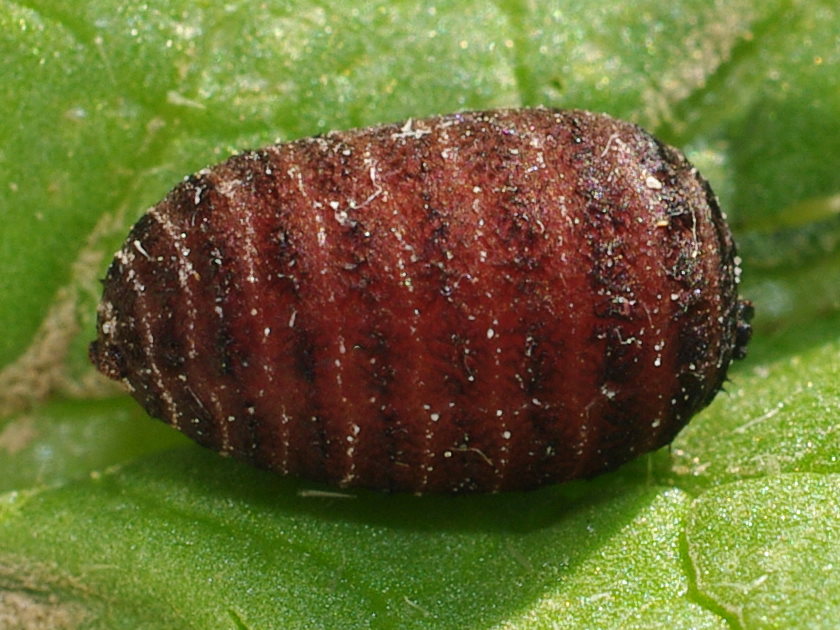Diptera.info :: Identification queries :: Diptera (eggs, larvae, pupae)
|
Larva and Pupa of Endoparasitoid
|
|
| Marion Friedrich |
Posted on 09-09-2016 09:38
|
|
Member Location: Saxony, Germany Posts: 1176 Joined: 07.10.09 |
Hello, I suspect that it is a fly larva, but I am not sure. The host of this larva was a nice caterpillar of Deilephila elpenor. On August 31th I found the caterpillar and offered Impatiens glandulifera, but it did not eat. On the next day the caterpillar was hidden in the kitchen paper below the Impatiens. I waited some days before I searched for the pupa. I dipped the Deilephila puparium for a short time in water to get rid of the kitchen paper where the caterpillar has wrapped in before pupation. Unfortunately, the pupation was incomplete and the unwrapped pupa dead. About 2 hours later I found the larva shown here outside the Deilephila puparium. The larva was about 15 mm. On the next day it had pupated. The size of the thick pupa is 8 mm. Is it a fly larva and is further ID possible? Thanks, Marion Marion Friedrich attached the following image:  [99.8Kb] Edited by Marion Friedrich on 09-09-2016 09:43 |
| Marion Friedrich |
Posted on 09-09-2016 09:39
|
|
Member Location: Saxony, Germany Posts: 1176 Joined: 07.10.09 |
2nd picture
Marion Friedrich attached the following image:  [133.99Kb] |
| Marion Friedrich |
Posted on 09-09-2016 09:40
|
|
Member Location: Saxony, Germany Posts: 1176 Joined: 07.10.09 |
3rd picture
Marion Friedrich attached the following image:  [133.39Kb] |
| atylotus |
Posted on 09-09-2016 10:40
|
|
Member Location: Amsterdam, NL Posts: 1172 Joined: 29.05.09 |
it is a fly larva, but don't know the family name |
|
|
|
| John Carr |
Posted on 09-09-2016 20:43
|
|
Super Administrator Location: Colorado, USA Posts: 10555 Joined: 22.10.10 |
Given the host the most likely families are Tachinidae and Sarcophagidae. Tachinidae typically have spiracles raised, like your fly, while Sarcophagidae have spiracles in a depression. Tachinidae key out in two places in Manual of Nearctic Diptera: "Posterior spiracles each with numerous openings elevated on a coral-like sculpturing of the spiracular plate; spiracular plate usually more or less clearly tripartite." "Posterior spiracles often heavily sclerotized, usually at least slightly elevated above plane of segment; each spiracle with three to several short to long spiracular openings thit are serpentine, bowed, or variously bent, but occasionally straight and often following distinct ridges on the spiracular place; spiracular opening arranged more or less radially around ecdysial scar but almost never in a predominantly vertical axis." Sarcophagidae key out once: "Posterior spiracles in a deep spiracular cavity; spiracular openings inclined more or less vertically; ecdysial scar usually not visible; peritreme incompletely encircling spiracular plate." |
| Marion Friedrich |
Posted on 10-09-2016 09:14
|
|
Member Location: Saxony, Germany Posts: 1176 Joined: 07.10.09 |
Many thanks for help. In the evening I will look in detail to all my pictures and compare with the key. I hope that the fly will hatch this year and reveal its identity. If this happens I let you know. Marion Edited by Marion Friedrich on 10-09-2016 09:15 |
| Marion Friedrich |
Posted on 10-10-2016 18:41
|
|
Member Location: Saxony, Germany Posts: 1176 Joined: 07.10.09 |
Hello, the pupa darkened, but the fly will not hatch. I successfully overwintered some pupae of lepidoptera, but until now I did not succeed with diptera. Is it ok to store the pupa in the fridge? Does it need humid or dry conditions? Thanks, Marion |
| John Carr |
Posted on 10-10-2016 21:46
|
|
Super Administrator Location: Colorado, USA Posts: 10555 Joined: 22.10.10 |
The common parasitoid of Deilephila elpenor is Drino lota, which has one generation per year. (Information from guide to Tachinidae of Central Europe by Tschorsnig and Herting.) Shallow soil may be best to approximate natural conditions. It may need a slight freeze in January to break diapause. See also https://bugtracks...m/rearing/. |
| Marion Friedrich |
Posted on 11-10-2016 18:23
|
|
Member Location: Saxony, Germany Posts: 1176 Joined: 07.10.09 |
Thanks for the link and instructions for rearing. I hope that the fly will survive. I (or more exactly Goggle) found here in the forum pictures of larvae and pupae of Drino lota looking just like my pictures of the parasitoid. Marion |
| Jump to Forum: |













